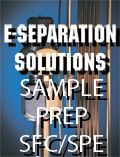Stability Indicating Methods
The answer to the following reader question about stability indicating methods was supplied by LCGC’s “ Validation Viewpoint ” columnist Michael Swartz.
The answer to the following reader question about stability indicating methods was supplied by LCGC’s “ Validation Viewpoint ” columnist Michael Swartz.
Q: If an assay method is by UV or titration for release testing, what should be used for shelf-life or stability testing? Can we use the same UV or titration method for a stability study or for shelf life specification for the determination of an assay test? If the related substance test is by HPLC for release testing, should we develop another stability indicating method or can we use the same test method given in the pharmacopoeia? Also, can we use same related-substance HPLC method for the assay test? Is it a requirement to have an HPLC method for a stability study or shelf-life specification? Are non-HPLC methods acceptable?
Michael Swartz: In my opinion, a stability indicating method can be any analytical method capable of measuring a loss of API upon storage. In other words, whatever method is used, it must be able to discriminate between the API and any degradants/impurities/excipients, and measure the potential loss upon degradation. In early studies, or in forced degradation studies, it might also be desired to measure the degradants as well.
Many methods these days are developed as combination methods, one method for related substances and assay. It puts a little more demand on the method from a validation standpoint (for example, it must perform over a wide range), but is acceptable. My preference however is to have separate methods, validated for their intended purpose.
LCGC answers your technical questions. Each month, one question will be selected to appear in this space, so we welcome your submissions. Please send all questions to the attention of "Ask LCGC" at lcgcedit@lcgcmag.com. We look forward to hearing from you.
Best of the Week: Food Analysis, Chemical Migration in Plastic Bottles, STEM Researcher of the Year
December 20th 2024Top articles published this week include the launch of our “From Lab to Table” content series, a Q&A interview about using liquid chromatography–high-resolution mass spectrometry (LC–HRMS) to assess chemical hazards in plastic bottles, and a piece recognizing Brett Paull for being named Tasmanian STEM Researcher of the Year.
Using LC-MS/MS to Measure Testosterone in Dried Blood Spots
December 19th 2024Testosterone measurements are typically performed using serum or plasma, but this presents several logistical challenges, especially for sample collection, storage, and transport. In a recently published article, Yehudah Gruenstein of the University of Miami explored key insights gained from dried blood spot assay validation for testosterone measurement.
Determination of Pharmaceuticals by Capillary HPLC-MS/MS (Dec 2024)
December 19th 2024This application note demonstrates the use of a compact portable capillary liquid chromatograph, the Axcend Focus LC, coupled to an Agilent Ultivo triple quadrupole mass spectrometer for quantitative analysis of pharmaceutical drugs in model aqueous samples.
